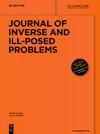一类反问题的稳定性
IF 0.9
4区 数学
Q2 MATHEMATICS
引用次数: 0
摘要
摘要建立了一类逆问题的Lipschitz稳定性性质。在该类中,相关的直接问题由一个积分算子A m \mathcal{A}_{m}非线性地依赖于一个参数𝑚并作用于一个函数𝑢来表述。在反演步骤中,𝑢和𝑚都是未知的,但我们只对收回𝑚感兴趣。我们讨论了应用于地震学的弹性方程反问题和电磁理论中的反散射问题的例子。假设a m \数学{a}_{m}的一些注入性和正则性,证明了有限个数数据点的反问题是可解的,且解在数据中是Lipschitz稳定的。我们展示了一个重建的例子来说明神经网络的使用。本文章由计算机程序翻译,如有差异,请以英文原文为准。
Stability properties for a class of inverse problems
Abstract We establish Lipschitz stability properties for a class of inverse problems. In that class, the associated direct problem is formulated by an integral operator A m \mathcal{A}_{m} depending nonlinearly on a parameter 𝑚 and operating on a function 𝑢. In the inversion step, both 𝑢 and 𝑚 are unknown, but we are only interested in recovering 𝑚. We discuss examples of such inverse problems for the elasticity equation with applications to seismology and for the inverse scattering problem in electromagnetic theory. Assuming a few injectivity and regularity properties for A m \mathcal{A}_{m} , we prove that the inverse problem with a finite number of data points is solvable and that the solution is Lipschitz stable in the data. We show a reconstruction example illustrating the use of neural networks.
求助全文
通过发布文献求助,成功后即可免费获取论文全文。
去求助
来源期刊

Journal of Inverse and Ill-Posed Problems
MATHEMATICS, APPLIED-MATHEMATICS
CiteScore
2.60
自引率
9.10%
发文量
48
审稿时长
>12 weeks
期刊介绍:
This journal aims to present original articles on the theory, numerics and applications of inverse and ill-posed problems. These inverse and ill-posed problems arise in mathematical physics and mathematical analysis, geophysics, acoustics, electrodynamics, tomography, medicine, ecology, financial mathematics etc. Articles on the construction and justification of new numerical algorithms of inverse problem solutions are also published.
Issues of the Journal of Inverse and Ill-Posed Problems contain high quality papers which have an innovative approach and topical interest.
The following topics are covered:
Inverse problems
existence and uniqueness theorems
stability estimates
optimization and identification problems
numerical methods
Ill-posed problems
regularization theory
operator equations
integral geometry
Applications
inverse problems in geophysics, electrodynamics and acoustics
inverse problems in ecology
inverse and ill-posed problems in medicine
mathematical problems of tomography
 求助内容:
求助内容: 应助结果提醒方式:
应助结果提醒方式:


